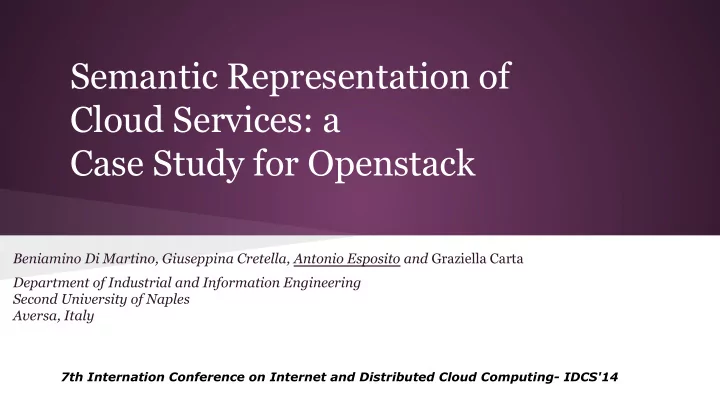

Semantic Representation of Cloud Services: a Case Study for Openstack Beniamino Di Martino, Giuseppina Cretella, Antonio Esposito and Graziella Carta Department of Industrial and Information Engineering Second University of Naples Aversa, Italy 7th Internation Conference on Internet and Distributed Cloud Computing- IDCS'14
Cloud Computing: Opportunities... ● Reduced up-front investment and maintenance costs In-house infrastructures substituted by Cloud resources ○ ● Better use of existing hardware Cloud infrastructure auto-scales according to requests ○ ● “Pay as you Go” paradigm ● Enhanced resiliency and disaster recovery Distributed and replicated data centers ensure data safety ○ ● Strong competition can lead to better quality services
… and challenges ● High variety of offered services → Several interfaces ○ How to (automatically) choose the right provider? Use of standard interfaces is still poor ○ Vendor lock-in problem ○ ● Data formats may vary from provider to provider ● Clouds expose available functionalities via Web services Operations’ signatures vary ○ Parameters’ semantics is the same ○ ● Portability (to and across Cloud platforms) ● Interoperability (also hybrid scenarios)
Objectives ● Categorization of services to support the choice of the right solution Functional and non-functional characteristics sould be considered ○ ● Uniform description of Cloud services and resources’ configurations ○ Compliance with standards ● Enable comparison and mapping among different provider’s services Simplify catalogues’ navigation ○ ● Use a single API call to access cloud resources on different provider platforms ○ API parameters need to be comparable too
How Semantic can help ● Provide a machine readable format for services’ and resources’ descriptions ○ Using a standard formalism ● Automatic evaluation and navigation of available resources ● Uniform and agnostic description of both functional and non-functional aspects ● Overcome of the syntactic differences in API descriptions
Semantic technologies ● Web Ontology Language (OWL) ○ OWL is for processing information on the web ○ OWL was designed to be interpreted by computers, not read by people ○ OWL is written in XML ○ Ontology: description of things and their relationships ● OWL-S (OWL for services) Ontology for the description of Semantic Web Services ○ ○ Discovery, invocation, management and monitoring of services Dynamic description of services ○ ○ Management of services’ orchestration ● SPARQL Protocol and RDF Query Language ○ Query Language for RDF databases (OWL is based on RDF) ○ Allows simple and fast interrogations on large RDF ontologies ○ Queries can be automatically written
OWL-S Model
Openstack Services Service included in the Provider Ontology (names refer to Icehouse release ) Shared services: Core services: ● Image Service (Glance) ● Compute (Nova) ● Identity Service (Keystone) ● Object Storage (Swift) ● Telemetry Service (Ceilometer) ● Block Storage (Cinder) ● Orchestration Service (Heat) ● Networking (Neutron) ● Database Service (Trove)
Semantic Representation of Services Agnostic Neutral Cloud Service Paramters Ontology representation Ontology Services classification Parameters classification Vendor Provider OWL-S specific Ontology orchestration representation
The Cloud Service Ontology
The Cloud Service Ontology Property Domain Range Meaning aKindOf Cloud Service/Virtual Appliance Service Category Specifies the category of a service or appliance equivalence Cloud Service/Virtual Appliance Cloud Service/Virtual Appliance Asses equivalence between services hasVendor Virtual Appliance Company Specifies the Company offering the appliance hasVirtualizer Virtual Appliance Company Specifies the virtualizer needed isModel Cloud Service ModelCloudService Specifies the service model supports Cloud Service API Specifies the API technology used offeredBy Cloud Service/Virtual Appliance CloudProvider Specifies the provider of the service or suporting the appliance
The Parameter Ontology
The Cloud Provider Ontology: Openstack ● _Method classes define operations exposed by a service ● _Parameter classes define input/output parameters ● isInput/isOutput properties connect a parameter to a method ● Each parameter instance is connected to the agnostic parameter ontology
Neutron Method Class
Neutron Parameters
Resources Configurations Flavor Disk vCPU EphemeralStorage Memory tiny 1 1 0 512 MB small 10 1 20 2048 MB medium 10 2 40 4096 MB large 10 4 80 8192 MB xlarge 10 8 160 16384 MB
OWL-S Annotation ● Neutron_Process is a SimpleProcess ○ Directly connected to the Neutron_Service description ● Others are Atomic processes ○ Each Neutron Method is connected to an atomic process ● hasOutput and hasInput properties used for parameters
Querying the knowledge base\1 SELECT ?category ?equivalentService Select all services falling in the same WHERE { category of Openstack Neutron CSo:OpenStack_Neutron this:aKindOf ?category. ?equivalentService CSo:aKindOf ?category} Category EquivalentService NetworkAdministration Azure_VirtualNetwork, BrocadeVyatta_vRouter, RedHat_JBossOperationNetwork, NetworkLoadBalancing Zeus_ExtensibleTrafficManager, Azure_TrafficManager, Amazon_ElasticLoadBalancer ApplicationLoadBalancing Azure_TrafficManager, Amazon_ElasticLoadBalancer Amazon_AppStream
Querying the knowledge base\2 SELECT ?resource vendor ? CPU ? Memory Select resources configurations WHERE { ? resource rdf:type pO:ResourceConfiguration. offering a minimum number of virtual ?resource pO:hasVendor ?vendor. CPUs ?resource pO:vCPUs ?CPU. ?resource pO:Memory ?Memory . FILTER (?CPU>=3) } Resource Configuration Vendor vCPUs Memory xlarge Openstack 8 16384 MB large Openstack 4 8192 MB A3 Azure 4 7 GB A4 Azure 8 14 GB CP3 MyPlatform 3 5 GB
Conclusions and future works ● Needed a better categorization of services ○ Equivalence assessed on the base of methods exposed ● Automatic inference rules (SWRL?) to determine parameters and services equivalences ● Cloud Computing Patterns can be used to define a template for applications’ orchestration A semantic representation of them can be queried to retrieve ○ information on applications’ workflows
Thanks for your attention
Recommend
More recommend